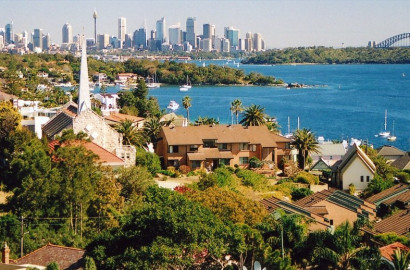The challenges posed by rising interest rates, strained affordability, and the looming 'fixed rate cliff' have subjected the housing market to rigorous stress testing throughout 2023. Nevertheless, resilience has largely prevailed, as highlighted in CoreLogic's Best of the Best report.
Eliza Owen, Head of Research at CoreLogic, noted that home values have shown overall resilience under these conditions. However, there have been signs that high housing costs are taking their toll, and 2024 is expected to see more subdued capital growth.
"Housing activity saw a rebound in early 2023 as buyers capitalized on lower prices. Toward the end of the year, though, affordability constraints have become more pronounced, leading to a shift in demand toward the middle-to-lower end of the pricing spectrum," Ms. Owen explained.
Certainly, lower-priced housing markets like Perth, Brisbane, and Adelaide demonstrated remarkable resilience throughout the national downswing period, with strong annual growth observed until the end of November.
These observations are reflected in the Best of the Best results for 2023, which encapsulates the country's annual property performance and offers insights into the coming year.
The top 10 sales nationwide for the year featured familiar names such as Sydney's Eastern Suburbs, including Bellevue Hill and Vaucluse, Melbourne's Hawthorn and Toorak, and Coopers Shoot in the Byron Shire of the Northern Rivers region.
On a national scale, Mosman in Sydney's Lower North Shore recorded the highest total value of house sales over the 12 months to September, totaling $1.462 billion. Meanwhile, Surfers Paradise saw total unit sales reach $1.175 billion.
Best and worst performers for value growth:
In terms of capital city markets, Perth dominated, claiming eight of the top 10 spots for the strongest growth in house values. Areas such as Brookdale, Armadale, and Hilbert experienced annual growth rates of over 30.0%, with median house values under $550,000.
For unit markets, Perth (5), Brisbane (4), and Adelaide (1) took the lead in the top 10 for the largest gains. Units in Brisbane's Slacks Creek saw a remarkable surge of 27.4% over the year, with seven of the top 10 recording median values under $400,000.
On the flip side, the weakest capital city house suburbs were located in Hobart's upper end, with North Hobart and Taroona experiencing declines of -13.9% and -13.8%, respectively. The top 10 worst-performing unit markets were more diverse, spanning Hobart, Darwin, Melbourne, and Canberra.
Across regional Australia, Tralee in NSW emerged as the top-performing house market, boasting a capital growth rate of 34.2%. In contrast, QLD's Emerald saw the highest value growth for units at 20.9%. Rochester (VIC) was the worst-performing house market, with values declining by -26.0%, while Mudgee (NSW) recorded unit value falls of -11.4% over the past year.
Best performing rental markets:
In 2023, the housing market experienced significant net overseas migration due to the impact of COVID-related border closures on migration patterns. While this likely contributed to upward pressure on home values, it had a more pronounced effect on the rental market.
"Since the reopening of international borders, strong rent growth was exhibited in markets historically exposed to overseas migration, and this is also reflected in the Best of the Best results for 2023," Ms. Owen noted.
Nationally, Kensington in Sydney's Eastern suburbs saw the highest house rent growth in the year to November, with an increase of 24.9%. In the unit segment, Lakemba in Sydney's Inner South West saw rents soar by 28.1%, closely followed by Wiley Park, up by 28.0%.
In Western Australia, Kambalda East (15.5%) and Boulder (12.0%) recorded the highest gross rental yields nationally for houses and units, respectively.
2024 market outlook:
Looking ahead, Ms. Owen anticipates a more subdued residential housing market in 2024, as recent deterioration in various market metrics points in that direction.
"The pace of capital growth has gradually eased since June, especially in November. National transaction volumes declined an estimated -1.7% in November, which is unusual as sales volumes typically increase from October to November. This coincided with a decline in the combined capitals' clearance rate since June, averaging just 61.7% through November.
“The RBA forecasts a rise in the unemployment rate, GDP growth is slowing, disposable household income growth is waning, and the household saving rate is at its lowest since the GFC at just 1.1%. Combined with the expectation of sustained higher interest rates, households may find their budgets stretched further, possibly leading to increased financial stress.”
Ms. Owen also pointed out that while the weakening market conditions have primarily impacted the upper end of Australia's housing market, this trend may extend to more affordable segments in 2024. Loosening monetary policy towards the end of the year could potentially strengthen market conditions once again.
Regarding rents, Ms. Owen expects rental growth to continue slowing but not necessarily decline on a national scale. Several factors may contribute to this, including the normalization of net overseas migration, shifting rental demand toward more affordable markets and housing types, an increase in share housing and larger households, and an increase in rental supply as 'HomeBuilder' stimulus-related dwellings reach completion. Additionally, interest rate changes may impact rent value increases.
However, even if rent increases slow down, it does not guarantee rent reductions, and some markets, such as Canberra and Hobart, have seen modest declines in rent values in 2023. These declines, though, are relatively small compared to previous rent increases, and there are indications that the rate of decline may be stabilizing.
In conclusion, the housing market in 2023 faced challenges but remained resilient. However, 2024 is expected to bring a more subdued market, with various factors influencing both capital growth and rental trends. The situation will continue to evolve as the year progresses.
Related posts:
It appears that property values in Sydney are on an upward trend, albeit at a more moderate pace compared to the growth seen in 2023.
In a new real estate cycle, smart investors focus on building an asset base through capital growth before transitioning to passive cash flow generation.


 Sydney Property Market - The Forecast for 2024
Sydney Property Market - The Forecast for 2024
 2023: Resilience, recovery and an unlikely upswing
2023: Resilience, recovery and an unlikely upswing
 Capitalizing on Today’s Property Market: Growth vs. Cash Flow
Capitalizing on Today’s Property Market: Growth vs. Cash Flow